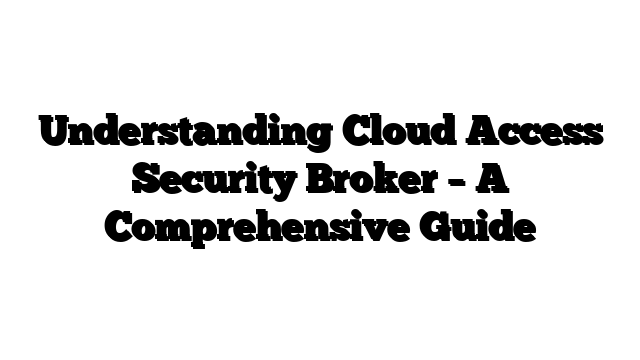A CASB is on-premises or cloud-based software that connects users and cloud applications to combine and interject enterprise security policies as cloud-based resources are accessed. These policies include authentication, authorization, device profiling, encryption, malware detection, and prevention.
A quality CASB solution should enable enterprises to safely deploy sanctioned and unsanctioned cloud services without sacrificing visibility or risking compliance. To do this, look for a solution that provides data classification to classify and protect cloud data across SaaS, IaaS, and the web. Do visit iCloud.
Autodiscovery
In addition to securing data flowing between an enterprise’s IT architecture and cloud vendor environments, CASB solutions also offer malware prevention. This is possible because CASBs can detect malicious activity in the cloud and alert IT departments. This allows them to respond quickly and prevent cyberattacks before they take hold.
Another critical function of a CASB is its ability to discover all third-party applications. This allows IT to understand how they are being used and determine their level of risk. This information can be used to create policies that protect against cloud-based threats. It can also be a valuable tool in reducing cloud spend by discovering redundant services or unnecessary costs.
When navigating the complexities of cloud security, one common question is, what is Cloud Access Security Broker? A Cloud Access Security Broker, or CASB, is a critical intermediary, providing organizations with enhanced visibility, control, and security over their data as it moves between on-premises devices and the cloud.
A CASB uses several techniques to identify each cloud application’sapplication’s risk, including autodiscovery and threat observation research. It can then classify these applications based on what type of data they contain and how it is shared. Using this classification, CASBs can make informed decisions about which applications to allow into their network and which to block entirely.
A CASB can also be used to enforce compliance standards. For example, it can help a healthcare organization comply with HITECH and HIPAA regulations or a retail company comply with PCI regulations. It can even ensure financial services companies comply with FINRA and FFIEC regulations.
API-centric approach
As enterprise employees use cloud-based applications on various devices, CASBs provide centralized visibility and control. They also help organizations comply with regulations and protect data against threats, including ransomware and malware.
Unlike inline security tools such as data loss prevention (DLP), which primarily protect inline data, CASBs also secure out-of-band data at rest in the cloud. In addition, CASBs offer a complete set of protection capabilities for all types of SaaS applications, whether sanctioned or unsanctioned.
CASBs are deployed as physical security appliances or software-as-a-service (SaaS) solutions, allowing them to inspect all traffic entering and leaving an organization’s corporate infrastructure. They provide visibility and control of third-party cloud apps used by employees, identifying the app, what sort of data it contains, and how it is being shared. This information helps enterprises make a risk assessment for each of their cloud apps and determine the best policies to secure them.
Most CASBs utilize a forward proxy architecture, intercepting cloud services on their way to the user’s device. This allows them to perform various security functions, such as logging, alerting, device posture profiling, malware detection, encryption, and tokenization. They also analyze each application deeper to determine the risk level and identify unusual behavior. They can then take action to protect the data and users.
Policy enforcement center
With the rise of remote working, bring-your-own-device (BYOD) programs, and unsanctioned cloud application use, it has become essential for organizations to monitor, control, and secure their data and applications. A CASB allows your security team to take a granular approach to cloud usage, allowing you to govern apps based on identity, service, activity, and more. For example, a CASB can automatically detect and block unauthorized data or app access on unmanaged devices.
In addition, a CASB can be used to identify and resolve misconfigurations in your infrastructure. This can prevent costly data breaches and re-mediate existing ones. Similarly, it can stop shadow IT and unauthorized apps by detecting if employees are using a product they don’t have permission to use or monitoring when off-network.
Unlike cobbled-together tools, a multimode CASB offers multiple services and security policies in a single platform. This includes multi-cloud auto-discovery, policy management, device profiling, logging, alerting, malware detection, encryption, and tokenization. This helps your security team save time and effort, reduce IT complexity, and ensure consistent security across SaaS, IaaS, and the web. It also eliminates policy conflict through standardized categories for each type of service. Moreover, it provides a unified view of your cloud environment and helps you understand your spending. This will help you improve budgets and increase efficiency.
Security controls
The cloud offers businesses new ways to be agile, collaborative, and cost-efficient, but those changes pose security challenges. How do you gain visibility into the use of cloud apps and whether data is protected? How do you ensure sensitive documents are not being shared inappropriately and that you adhere to critical compliance regulations?
A CASB provides visibility, data security with DLP, and threat protection to utilize cloud applications safely. CASB solutions are designed to be deployed on-premises or in the cloud and work by monitoring, protecting, and enforcing security policies against data as it moves between cloud applications.
By discovering all resources provisioned on the cloud, a CASB solution can identify and classify each app, determine what type of data is stored in it, how the application shares that data, and evaluate the risk level of each. Once the full range of cloud apps is identified, a CASB can automatically set data and user access controls to meet enterprise security requirements and enforce them in real-time.
Some CASB features include malware prevention, which analyzes file content and detects and rejects suspicious data; encryption that prevents eavesdropping by attackers and protects sensitive information from theft after an employee loses their corporate device; and multifactor authentication to ensure secure logins. Other CASB features enable you to discover and control shadow IT and rogue services and protect data in the case of a breach.
James Martin is a passionate writer and the founder of OnTimeMagazines & EastLifePro. He loves to write principally about technology trends. He loves to share his opinion on what’s happening in tech around the world.


